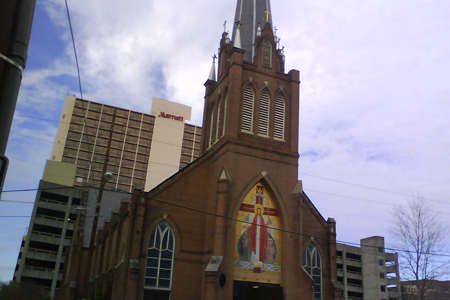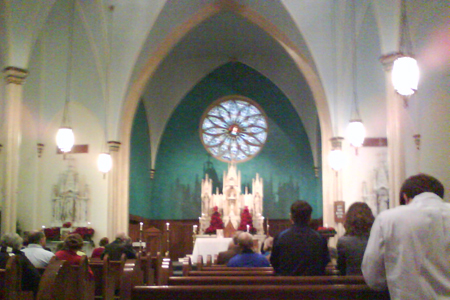| |
 |
 |
 |
| Comment on this report, or find other reports. |
 |
| Our Mystery Worshippers are volunteers who warm church pews for us around the world. If you'd like to become a Mystery Worshipper, start here. |
 |
| Find out how to reproduce this report in your church magazine or website. |
|
|
| 1656: Cathedral
of St Peter the Apostle, Jackson, Mississippi, USA |
 |
 |
 |
Mystery Worshipper:
Sir Thomas Browne.
The church:
Cathedral of St Peter the Apostle, Jackson, Mississippi, USA.
Denomination:
Roman Catholic, Diocese
of Jackson.
The building:
Two earlier buildings preceded the present one. The first of
those, dating from 1846, was burned during the Civil War by
General William Tecumseh Sherman; the second was likewise burned.
The present structure dates from 1897 and was expanded recently
without impinging on the original design. It is a lovely red
brick structure in the Gothic Revival style. The inside is not
large, hardly bigger than a typical parish church, but manages
to include some statues and side altars without looking cluttered.
A handsome pipe organ graces the rear gallery. There is some
very ornate and attractive stained glass. The high altar is
backed by an elaborate reredos, but the effect is masked by
the westward-facing communion table in front of it. Immediately
below the high altar is the episcopal throne, which was unoccupied.
The church:
As the seat of the Bishop of Jackson, St Peter's is the mother
church of the diocese and draws its congregation from all over.
In addition to a Saturday evening vigil mass, three masses are
celebrated each Sunday, including one in Spanish. One mass is
celebrated each weekday.
The neighborhood:
Jackson, the capital of Mississippi, was named in honor of President
Andrew Jackson. During the Civil War, Jackson was a strategic
manufacturing and railroad center for the Confederacy, and as
such suffered much damage at the hands of Union troops. Today
few antebellum structures remain, a notable exception being
the Governor's Mansion. During the 1960s Jackson was the site
of numerous civil rights actions, witnessing the murder of black
activist Medgar Evers in 1963 and the bombing of the Beth Israel
synagogue by the Ku Klux Klan in 1967. Famous sons and daughters
include Richard Wright, whose memoir Black Boy describes
the horrors of segregation in the early 20th century, and Eudora
Welty, whose writings (especially her short stories) present
a portrait of Southern living in days gone by. St Peter's sits
right in the center of Jackson, just down the street from the
Capitol and the Governor's Mansion.
The cast:
The preacher and celebrant was the Revd Brian Kaskie, rector
of the cathedral.
The date & time:
Feast of the Holy Family, Sunday, December 28, 2008, 10.30am.
What was the name of the service?
Mass.
How full was the building?
I'd say there were 200-250 people. The nave was pretty full,
and every pew, from the very front to the very back, had at
least a few people in it. There was a great mix of people, both
in terms of age and ethnicity. There were people in suits and
people in jeans. Even though no one particularly spoke to me
(aside from the peace), they all seemed friendly and I didn't
feel at all unwelcome.
Did anyone welcome you
personally?
No.
Was your pew comfortable?
Yes. The kneelers were surprisingly comfortable as well.
How would you describe the pre-service
atmosphere?
Quiet and reverent, with a little bit of chatter audible from the narthex.
What were the exact opening words of the
service?
"Good morning and welcome to this 10.30 liturgy at St Peter's
Cathedral. Please turn off your cell phones if you haven't already."
What books did the congregation use during the
service?
Worship, a typical American Catholic hymnal/service
book.
What musical instruments were played?
A very pleasant pipe organ in the back.

Did anything distract you?
The cantor (who had a nice voice even if I could never understand what words he was singing) kept darting in and out from behind the high altar (which was not functional as an altar but more of a stage piece) between songs.
Was the worship stiff-upper-lip, happy clappy, or
what?
It was informal, low-church American Catholicism. No incense,
very little ceremonial, only a small group of acolytes with
the celebrant. I was a little surprised that the bishop did
not attend, even if only in choir, but then again it was a holiday
weekend. The music was all well played, but the congregation
didn't seem to be that interested in singing it. And why bother
when there's a cantor up there to do it all for you? I'll confess,
I'm a traditional Anglo-Catholic, so it's always weird to find
myself in the One True Church and be the only one actually bowing
and making the sign of the cross and whatnot.
Exactly how long was the sermon?
15 minutes.
On a scale of 1-10, how good was the preacher?
5 – Father Kaskie was easy to listen to, but if you're
going to preach for 15 minutes, I think some organization might
be a good idea. The first 10 minutes sounded more like a talk
from the pop psychologist TV personality Dr Phil than a Christian
sermon. Then, when he finally got to talking about the scriptures
and the feast, there were too many disparate points for there
to be any one coherent theme.
In a nutshell, what was the sermon
about?
Family is a good thing, even when it's hard (and, by the way,
marriage is between a man and a woman).
Which part of the service was like being in
heaven?
The building itself was a joy to see, and the stone high altar
is quite beautiful. Being there surrounded by the faithful was
a blessing. The few minutes before mass began were the best.
And which part was like being in... er... the other place?
(1) The almost complete lack of solemnity once the service started.
(2) The cantor's popping in and out, so distracting and so completely
unnecessary – he even popped out in the middle of the eucharistic
prayer to sing the responses! (3) The rambling sermon. (4) The
sad, tiny little table that was put out front as an altar. That
all sounds rather bad; none of these things were in themselves
unbearable, but they do add up to a badly done liturgy, one
very much out-of-step with the liturgical directives of the
current pope.
What happened when you hung around after the service looking lost?
No one spoke to me. I wandered up to the front and stood looking
around, then kind of stood in the back for a while too.
How would you describe the after-service
coffee?
I don't think there was any.
How would you feel about making this church your regular (where 10 = ecstatic, 0 = terminal)?
5 – It was full of people of diverse ages and ethnicities,
and I think being part of the community would do a lot to make
up for the deficiencies (at least as I saw it) in liturgical
life.
Did the service make you feel glad to be a
Christian?
Not especially. Other than an aside on Christian marriage, I'm
not sure if the sermon had anything distinctively Christian
(much less Catholic) to say. Then again, I'm always happy to
be at mass, so it didn't make me feel bad about being a Christian!
What one thing will you remember about all this in seven days' time?
The cantor darting out from behind the high altar to sing his
parts. |
|
|
 |
 |
 |
| We rely on voluntary donations to stay online. If you're a regular visitor to Ship of Fools, please consider supporting us. |
 |
 |
 |
| The Mystery Pilgrim |
 |
| One of our most seasoned reporters makes the Camino pilgrimage to Santiago de Compostela in Spain. Read here. |
 |
 |
 |
| London churches |
 |
| Read reports from 70 London churches, visited by a small army of Mystery Worshippers on one single Sunday. Read here. |
| |
|
|
|
|


